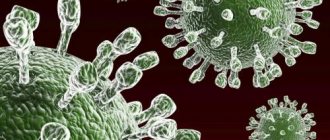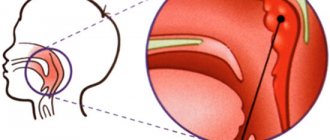Features of the digestive system in infants
The structure of the digestive system organs differs significantly between a newborn and an adult. The baby has an intestine that is larger than the baby's body length. In an adult, the size of the small intestine does not exceed 10 cm, in a baby - 1 m. The excess length is associated with the nutritional characteristics of a newborn child.
The lactation period, which does not contain solid, thick food, is characterized by parietal digestion.
A newborn is characterized by the process of regurgitation of food , which is associated with the structural features of the esophagus. The organ is short, the sphincter that holds food is insufficiently powerful. As a result, after eating, the contents are thrown back, manifested by regurgitation.
If the smell of the regurgitated contents is sour, the milk reached the stomach, curdled, came back out, if there is no smell, the food did not reach the esophagus. The normal volume of regurgitation is considered to be 1-2 tbsp. spoons during the first 4 months of life. By the age of six months, the baby, as a rule, stops regurgitating.
You can reduce the amount of regurgitation by:
- feed the baby more slowly;
- avoid overeating;
- do not turn over or shake the baby after feeding;
- change the position of the child during meals with frequent regurgitation;
- If the baby is bottle-fed, replace the formula.
The baby's stomach is very small; in the first day it can hold about 10 ml of milk. By 2 weeks of life, the organ increases in size and reaches approximately 80 ml in volume. On average, a baby's stomach increases by 23 ml every month. In the first months of life, a baby is characterized by frequent hiccups. The process is associated with breathing patterns, contractions of the diaphragm connecting the chest cavity and stomach.
The hiccups go away in the child after 10-15 minutes, without causing associated symptoms.
Hiccups can be caused by:
- overeating when the baby received a larger portion of milk than the stomach could accept;
- overexcitation (unexpected touching of a child, loud noises, an unfamiliar voice can provoke hiccups);
- lack of water (when the newborn’s mucous surface of the oral cavity and digestive canal dries out).
Milk consumption standards for infants can be found here:
To help your baby with hiccups, just follow the basic rules of feeding:
- do not overfeed;
- give the child a small amount of water;
- Do not place the child immediately in a horizontal position after eating.
In the first months of life, the baby’s digestive system performs the main task of digesting breast milk.
Stool standards for breastfed infants
A baby's stool is special, different from an adult's. Normal bowel movements can be determined by characteristic signs: smell, frequency, consistency, color.
Frequency
The frequency of bowel movements depends on the chosen diet (scheduled or on demand), the mother’s menu, time of day, and the baby’s personality. The first stool of a newborn is called meconium and occurs on the first day after the baby is born. Characterized by black color.
The frequency of stool at birth depends on the mother's nutrition.
If a woman eats foods that have a laxative effect, the child will have frequent bowel movements. Normally, a breastfed baby should poop from 1 to every time after eating. The frequency depends on the work of the intestines. By the third week, the baby poops 1 to 5 times a day.
At the age of 1.5 months, the frequency of bowel movements may decrease, which is normal. The phenomenon is associated with enzymatic processes in the baby’s body. The mother’s milk changes, becoming richer and more nutritious, which requires the baby’s digestive system to produce new enzymes responsible for the digestion and absorption of substances.
The adaptation process lasts from 1 to 3 weeks.
By 3 months, the child’s stool frequency becomes individual, depending on the characteristics of the gastrointestinal tract and the mother’s diet. During this period, the baby can poop from once a day to 10 or more times. Any indicators without additional unpleasant signs will be the norm. The frequency of stool is proportional to the quality of milk, the mother’s nutrition, and the functioning of the newborn’s intestines.
At 4-6 months, complementary foods are introduced. According to WHO recommendations, it is better for a breastfed baby to introduce new foods into the diet starting from the age of six months. During this period, enzymatic processes are sufficiently developed, the intestines are able to digest additional food that differs from mother's milk.
Doctor Komarovsky E.O. does not advise focusing on the norms and indicators established in pediatric practice when breastfeeding.
Each child is individual, if there are no unpleasant manifestations in the form of painful colic, abdominal pain , increased gas, strong odor, the frequency of stool is regulated depending on the needs of the baby and his digestive system.
Color
When inexperienced young mothers notice the unnatural color of their newborn’s stool, they begin to panic. A baby cannot have stools that are similar in color to those of an adult , which is due to the characteristics of the baby’s digestive system.
The normal color of stool for a baby in the first year of life will be:
- yellow;
- yellow-green;
- yellowish with an admixture of white lumps;
- golden;
- green.
The baby's stool becomes brown after a gradual, full transition to complementary feeding. If the baby eats vegetables, fruits, cereals most of the time, the feces become more shaped and similar in color to an adult.
Smell
The stool of a breastfed newborn will be different from the stool of a bottle-fed baby. If the baby feeds on mother's milk, the feces will not have an unpleasant odor , which is due to the peculiarities of digestion of mother's milk and its composition.
Slightly acidic stool is also normal.
Consistency
Since the baby receives light food (mother's milk) for the first six months of life, the consistency of the stool is unsolid, mushy, and liquid.
Normally, the baby is not bothered by additional signs inherent in diarrhea:
- increased frequency of bowel movements;
- stool changes from liquid to watery;
- vomiting begins;
- the child is weak, capricious, lethargic;
- the baby's body temperature rises;
- There is an admixture of blood and foam in the stool.
These signs indicate pathological stool, when medical help is needed.
There may be impurities in a newborn's stool, which is considered normal at this age. When your baby defecates, you may find white lumps, mucus, and undigested food particles. There should be no blood or foam in the stool of a breastfed baby.
The first symptom indicates disturbances in the gastrointestinal tract, the second - increased flatulence, functional impairment.
NEW LEVEL
The stool of a child changes several times from the moment of birth until the introduction of complementary foods . At first it is viscous, almost black meconium, which accumulates in the baby while it is in the mother’s belly, and after birth it begins to come out. The color of the stool in the first days is an important indicator of the baby’s adequate nutrition! By the third day, as the baby receives more milk/colostrum, the stool becomes lighter. If on the fourth or fifth day the baby poops meconium, it is urgent to assess whether the baby is getting enough milk and improve the organization of feeding.
By the end of the first week, the child usually has bowel movements at least 2-3 times a day, and he already has the usual “milky stool” - liquid or pasty, mustard-colored, usually with only a slight sour-milk odor. Options are also possible - the stool ranges from green to orange in color and may contain mucus and white lumps. If the appearance of the stool is exactly like this, and the child otherwise feels normal and is gaining well (according to WHO standards, at least 125 g per week, counting from the minimum weight), there is no need to worry.
As the child grows, the frequency of bowel movements gradually changes. During the first weeks, children do “this” at least once a day, every day. This often happens every breastfeeding. If a baby under 4-6 weeks poops less than once a day, most likely he is not getting enough milk [10], and it makes sense to check the baby’s weight earlier than at the end of the month (for example, go to the clinic). Let us remind you that the minimum weight gain during this period, according to WHO, is 125 g per week. If you notice a lack of weight in time, you can correct the situation by changing the organization of feedings before you need to supplement with artificial formula.
However, after 6 weeks, the baby may switch to a less frequent bowel movement schedule . For example, during this period (AFTER 4-6 weeks and BEFORE the introduction of complementary foods) many children have stool once every few days [14]. During this period, the child may periodically pass gas, and then, completely calmly and without tension, the child can empty his intestines, for example, at the end of the fifth day. At the same time, if the stool is soft in consistency and large in volume, this is not constipation for an infant. Signs of constipation are hard, formed stools that resemble “goat nuts,” causing great discomfort in the child during bowel movements.
A stool once every five days may seem abnormal to a medical professional, because such rare stools are not normal when bottle-fed, and it is on the basis of studies of bottle-fed children that many norms are derived in textbooks for future doctors. For a child on IV, bowel movements less often than once a day are considered a problem: the microflora in his intestines is much closer to the flora of an adult, and the norms of bowel movements are the same. While for infants the norms differ due to the unique characteristics of its nutrition and digestion. Firstly, breast milk, produced from the components of the mother's blood and lymph, is as close as possible to his needs, and is absorbed as well as no other product, being digested almost completely for some children. Secondly, when feeding exclusively on breast milk, the intestinal microflora has its own favorable characteristics - there is a higher content of bifidobacteria (up to 10 to 11 degrees), including due to the content of bifidus factor, N-acetylglucosamine and L-fucose in breast milk, which create unique conditions for the growth and reproduction of these bacteria. Bifidobacteria create an exceptionally favorable environment in the intestines, prevent the proliferation of opportunistic flora, and stop the development of putrefactive processes [12]. As you know, even the acidity of stool during breastfeeding is noticeably higher than during artificial feeding, which is an additional protective factor against the development of processes of rapid fermentation and putrefaction.
Breastfed babies have very different bowel movements - for example, in one study, a two-week-old baby did it eight times a day, while a two-month-old did so once every 27 days. Both babies were healthy, full-term babies ([3], Weaver et al, 1988) and doing well. When the second baby pooped after 27 days, the stool was soft and of large volume. The World Health Organization in a practical guide for health workers “Breastfeeding. How to ensure success? indicates that “a breastfed baby’s stool can be very soft and appear at intervals from several times a day to once every ten days” [2, p. 24]. Leading organizations and experts in the field of breastfeeding (Dr. Jack Newman [11], Savage King [9], La Leche League International [10], American Academy of Pediatricians [8]) agree that with normal development and well-being of the child, the interval between bowel movements can last up to a week or more . The findings of the Constipation Committee, established by the North American Society of Pediatric Gastroenterology to develop uniform clinical guidelines for constipation in children, are consistent with these expert opinions [7, 13]. After processing almost 4,000 scientific articles, the committee selected for final analysis 160 papers that best met the requirements of evidence-based medicine, as well as the topic of recommendations. Analysis including studies of infant stool (e.g. [4-6], Hyams et al, 1995; Fontana et al, 1989; Sievers et al, 1993) led the committee to conclude that “the frequency of stool in infants is much more variable, than the stool frequency of formula-fed children (4,89,90). If there is no suspicion that the child has Hirschsprung's disease, management of a breastfed child consists of reassuring the parents, monitoring weight gain and feeding of the child, and checking for signs of intestinal blockage or enterocolitis" [7]. Let us clarify that Hirschsprung's disease occurs in approximately one in 5,000 children. We also add that on average, the frequency of stool while breastfeeding in the first two months of life is one and a half to two times higher than the frequency of stool during artificial feeding, and by four months the average figures are comparable and equal to approximately 2 times a day.
According to the observations of breastfeeding consultants, the child’s stool frequency can also be influenced by his psychological state. The frequency of bowel movements may change, for example, due to a change in environment, moving, frequent attendance at crowded gatherings or having people at home, or water entering the child's mouth during bathing. Periods of illness or severe teething, problems with the intestinal function of the nursing mother herself (in particular, constipation or diarrhea) can also affect the condition. If problems arise with the baby's stool for one of the above reasons, it can be recommended to eliminate the cause and also check the organization of breastfeeding. The cause of problems may also be the child’s lack of so-called “hind”, fattier milk. The main recommendations to correct this problem are to ensure that the baby grasps the breast correctly, hold the baby at the breast longer until he releases the breast, and apply more often. It is best to have a lactation consultant help you check and adjust your feeding arrangements.
If, in addition to the unusual frequency of stool, the child is worried about something else -
- pain during bowel movements,
- stool shape – dry, shaped, dark in color, so-called. "goat"
- excessive regurgitation, restless behavior at the breast
- the child poops only with the help of a gas tube or an enema
- poor weight gain due to lack of milk or other reason
- or there is rare stool (less than once a day) with mixed feeding
- It’s better to contact a specialist. If possible, the doctor should support breastfeeding and be aware of the differences in stool frequency norms for breastfed and bottle-fed children.
In any case, if you are concerned about the health of your child, the best solution is to contact a competent medical professional, because... Not a single article on the Internet can replace a personal examination and individual recommendations.
I thank AKEV consultant Lilia Kazakova , certified lactation consultants (IBCLC) Irina Ryukhova and Maya Bolman , as well as Ph.D. Lyudmila Akhmaltdinova and biologist Natalya Baburina.
Literature:
1. Maria Gudanova. Baby health. "My Child", July 2009.
2. Tine Winther, Elisabeth Helsing. "Breast-feeding. How to ensure success? Practical guide for medical professionals. WHO, Regional Office for Europe, Copenhagen. 1997
3. Weaver LT, Ewing G., Taylor LC The bowel habit of milk-fed infants. J. Pediatr Gastroenterol Nutr, 1988
4. Hyams JS, Treem WR, Etienne NL, et al. Effect of infant formula on stool characteristics of young infants. Pediatrics 1995;95:50-4.
5. Fontana M, Bianchi C, Cataldo F, et al. Bowel frequency in healthy children. Acta Paediatr Scand 1989;78:682-4.
6. Sievers E, Oldigs HYD, SchultzYLell G, Schaub J. Faecal excretion in infants. Eur J Pediatr 1993;152:452-4.
7. Clinical Practice Guideline. Evaluation and Treatment of Constipation in Infants and Children: Recommendations of the North American Society for Pediatric Gastroenterology, Hepatology and Nutrition. JPGN 43:e1-e13, 2006
8. Website for parents from the American Academy of Pediatricians www.healthychildren.org, article “Baby's First Days: Bowel Movements & Urination” https://www.healthychildren.org/English/ages-stages/baby/Pages/Babys-First- Days-Bowel-Movements-and-Urination.aspx
9. Savage King, Helping Mothers Breastfeed. Reissued in 1995 by WHO as document WHO/CDR/95.8
10. Materials of the International League of La Leche Is my baby constipated, The importance of taking into account the frequency of stool of a newborn child.
11. Jack Newman “Is My Baby Getting Enough Milk?” https://breastfeeding.narod.ru/newman/enough.html
12. One bottle won't hurt. Or will it hurt? Marsha Walker, IBCLC.
13. Evaluation and Treatment of Functional Constipation in Infants and Children: Evidence-Based Recommendations From ESPGHAN and North American Society for Pediatric Gastroenterology, Hepatology and Nutrition MM Tabbers, C. DiLorenzo, MY Berger, C. Faure, MW Langendam, S. Nurko , A. Staiano, Y. Vandenplas, and M.A. Benninga, Journal of Pediatric Gastroenterology and Nutrition - Volume 58, Number 2, February 2014 https://www.naspghan.org//files/documents/pdfs/position-papers/Constipati ...
14. Factors associated with defecation patterns in 0-24-month-old children. Tunc VT1, Camurdan AD, Ilhan MN, Sahin F, Beyazova U. Eur J Pediatr. 2008 Dec https://www.ncbi.nlm.nih.gov/pubmed/18264719
Author Maria Sorokina , original article https://gvinfo.ru/stool
A photo of Irina Ryukhova from the ILCA conference was used in the design of the article. You can read more about infant stool in Tatyana Kondrashova’s article “What does a diaper tell you?”
Go to other articles for consultants of the “New Level” project
Normal stool in a formula-fed baby
The defecation of a bottle-fed baby will be different from that of a baby who drinks breast milk. Consistency, smell, frequency, color will vary depending on the type of feeding. Modern formulas are saturated with all the components necessary for the baby, helping to obtain microelements, vitamins, minerals, and enzymes that are important for health and development.
Frequency
If the baby switched to formula at birth, the frequency of stools will be rare compared to a breastfed baby, depending on the choice of food. As a rule, milk complementary foods contain many components that make it possible to saturate the child, which affects the digestion process.
The baby needs more time to digest the formula. A bottle-fed baby quickly adapts to a new diet; the frequency of bowel movements will be regulated by 2-3 months and will average from 1 to 3 bowel movements per day.
Color
The color of stool depends on the mixture chosen; normally it is yellow, golden, or orange. Unlike a newborn who feeds on mother's milk, an artificial baby should not have a green tint in his stool. This indicates disturbances in the functioning of the intestines (dysbacteriosis, rotavirus infection, enterocolitis).
There should also be no foam or blood present. The color of stool should not be bright yellow or orange, which indicates liver dysfunction.
Smell
The stool of a bottle-fed baby has a distinct odor. Parents must distinguish the pathological odor from the normal version when using the mixture. Naturally sour stool will have a mild to strong flavor. If a child is fed cow's milk, which is contraindicated according to the recommendations of pediatricians and the WHO, the smell may intensify and be putrid in nature.
A cause for concern should be feces with an unpleasant rotten aroma, accompanied by bloody inclusions and the presence of foam.
Consistency
When consuming the mixture, pediatricians advise carefully monitoring the consistency of the stool and avoiding solid discharge. The stool of a bottle-fed baby will be denser than that of a baby fed on mother's milk. This is due to the nutritional value of the mixture, the process of digesting a complex product.
Normally, stool should be mushy in shape. Denser stool is a recipe for constipation.
Color change
Yellow stool in a baby
Yellow-green feces in infants usually appear during the period of stabilization of the intestines and cleansing it of meconium residues, which is why it is often called transitional. It usually has a sour odor and a mushy consistency. This period lasts until the woman produces milk and is unable to fully meet the child’s nutritional needs.
Want to choose the best diaper for your newborn? Here is a ranking of the best brands!
After the baby completely switches to breastfeeding, he gradually begins to develop mature stools . Ideally, a 1-month are yellow or yellowish-golden in color, have a sour smell, and have a uniform consistency.
But each baby may have its own norm, so a small amount of mucus, lumps or whitish inclusions is acceptable. It is also common for a baby to have watery stools in the first months of life.
Mature stool during artificial feeding should also be uniform and yellow in color. However, newborn babies have different tolerances to the substances contained in the mixtures. Therefore, their feces may have a more pronounced pungent odor, dark color or thick consistency. And this is also the norm, so parents have nothing to worry about. The main thing is that the baby eats with appetite, gains weight well and does not lag behind in psychomotor development.
Green stool in baby
In the first days, a newborn undergoes many changes, including the body beginning to rid itself of original feces, or meconium. Meconium is a thick substance that is dark green or dark olive in color.
If during the first two days of the baby’s life the meconium has not passed, then this is a cause for concern. Such delays may indicate malnutrition of the child or some congenital diseases. One of the pathologies is meconium ileus - a condition of obstruction that occurs due to increased viscosity of feces, which results in blockage of the ileum.
However, if green stool in a child is considered normal in the first days after birth, then in the future this may indicate a number of problems.
The main reasons for the appearance of green stool in infants are:
- Malnutrition . If a child constantly screams, cries after eating, does not gain weight and sleeps poorly, and the stool is green, then all these symptoms indicate malnutrition (“hungry stool”).
- Diet of a nursing mother . A green tint to the stool of a breastfed newborn appears when the mother's diet is dominated by vegetables and fruits, which contain a lot of the coloring pigment chlorophyll.
- Intestinal problems . The cause is inflammatory diseases caused by hypoxic processes during childbirth or dysbiosis, which develops when the balance between beneficial and harmful bacteria in the colon is disturbed.
- Infectious diseases . When infected with salmonellosis, the stool becomes swamp-green in color and has a strong, foul odor and becomes too watery.
The stool of a formula-fed is green. The reason for this is the mixtures. If they contain an increased amount of iron, hydrolyzed protein (Nutrilon PEPTI TSC, Friso PEP) or partially degraded protein (NAN GA, HIPP, Tema GA), then the stool may have a green, olive or marsh color and have a pungent odor.
Red or dark stool in infants
The reason for the appearance of atypical coloring of stool in an infant is bleeding, which is caused by damage to either the upper parts of the digestive tract (small intestine and stomach) or the lower parts (colon or rectum, anus).
The location of the pathology can be determined by the color of blood in the stool. If the stool is black and tarry, then the disease is localized in the stomach or small intestine, since the released blood has already clotted under the action of enzymes. If bright red impurities are visible, then the lesion is located in the lower parts of the digestive tract.
It is also important to remember that some foods (beets, chocolate, flavored red gelatin) or medications (activated carbon, antibiotics, dye powders, iron supplements) can turn stool red-burgundy or dark in color.
Want to know what causes blood in diapers? Everything is described in this article!
How does stool change depending on what your child eats?
The stool of a breastfed baby differs depending on the mother's diet. The slightest changes in the menu of a nursing woman affect the condition of the baby's stool and the entire digestive process. If the mother consumes more products that have laxative properties, the baby will poop regularly and the consistency of the stool will be liquid.
The stool of a breastfed baby depends entirely on the diet of the mother of the newborn
With a menu that includes foods with increased gas production, the child develops gas, his stomach hurts, and his stool becomes foul-smelling. When a woman watches her diet and adheres to the diet of a nursing mother, the baby’s stool is mushy with a weak sour odor, yellowish-green with minor inclusions.
With artificial feeding, the baby's stool has a more viscous, dense consistency, with minor inclusions, rare acts of defecation, and a slightly foul aroma. The change is related to the nutritional value of the mixture. The baby needs more time to process the product; food remains in the intestines for a long time, which contributes to the unpleasant odor.
If constipation occurs
The appearance of thick stool is often accompanied by constipation. This phenomenon occurs in children who consume ready-made formulas instead of mother's milk. It is recommended for such babies to replace half the norm of artificial formula with fermented milk. But what should you do if thick stools and constipation occur in a breastfed baby? First of all, the mother needs to change the composition and standards of her diet, because what she eats enters the child’s body along with milk. It is worth including buckwheat, rice, oatmeal, steamed vegetables, dried apricots, kefir, and peaches in the menu. If the measures taken do not help, the baby may have intestinal dysfunction. These problems may be indicated by the baby's restless behavior, crying, and bloating if there is no relief after feeding.
In such a situation, you need to consult a doctor. Only he can correctly diagnose and prescribe treatment.
If you have constipation, it is strictly forbidden to:
- Independently develop the baby's anal sphincter with any objects.
- Do not insert cotton swabs, gas tubes, or thermometers into the anus - this can injure the delicate skin of the rectum and disrupt its elasticity.
- It is not allowed to do enemas, rinsing, etc.
Such actions can be carried out by a qualified doctor, and enemas can be given to children only after 6 months.
What do deviations from the norm mean?
Deviations from the norm indicate the presence of a pathological process in the baby’s body, or improper eating behavior of the mother if the child is breastfed. Pathology can be suspected based on accompanying symptoms.
Constipation
Irregular, difficult, painful bowel movements are called constipation.
Constipation (constipation) in an infant is accompanied by symptoms:
- absence of stool for 3 days, if the baby pooped daily before this period;
- increased flatulence;
- the child strains but does not poop;
- increased tearfulness;
- the child cries during bowel movements;
- The baby's stomach turns to stone.
The cause of constipation can be an incorrectly selected mixture, poor nutrition of the mother, decreased bowel function, organic damage to the organ, and endocrine disorders.
Diarrhea
It is characterized by an increased frequency of stools from 10 to 14 times a day. When a child has diarrhea, there are associated symptoms associated with the cause of the diarrhea.
| Associated symptoms | Cause of diarrhea |
| Poor weight gain, green stool color, with admixtures of undigested food. Increased frequency of bowel movements without fever. Seething in the stomach, increased gas formation. | Intestinal dysbiosis. |
| The stool is foamy, liquid, yellow. The baby is characterized by colic, increased flatulence, and a sharp sour smell of feces. | Lactose deficiency. |
| Increased body temperature, green stools, streaked with blood or mucus, frequent vomiting, pale skin, lethargy, increased moodiness. | Acute intestinal infection. |
Diarrhea can be non-pathological in nature when it is associated with teething in the baby or a reaction to improper feeding.
In the first case, there will be a slight increase in body temperature , increased salivation, swelling and hyperemia of the gums, and the baby puts everything in his mouth. The second case is easy to recognize; it will be associated with food intake, undigested food will be present in the stool, and frequent regurgitation after eating.
Change in the amount of stool
Irregularity and changes in the amount of feces are associated in 80% of cases with the baby’s nutrition. if changes occur (fasting, overeating, the mother switching to a normal diet without a diet) they stimulate changes in the child’s stool. We can talk about pathology if concomitant manifestations are observed in the form of an unpleasant odor, color change, the presence of blood, foam.
Changes in consistency
Feces may change consistency in the following situations:
- overfeeding;
- diarrhea;
- constipation;
- insufficient nutritional value of food;
- dehydration.
Pathological impurities
Pathological ones include increased secretion of mucus in the stool, blood, and foam. A slight appearance of mucus is normal for a baby's stool. If the component increases, most likely the mother introduced complementary foods early, the baby is overeating, the breast is not applied correctly, or the milk formula is not suitable.
Foam in the stool indicates increased flatulence, colic, dysbacteriosis, and intestinal infection. Blood signals serious inflammation, protein allergies, dermatitis, intestinal pathology, rectal fissures.
Foamy stool
Pathology can be determined by the color of stool. Light-colored, foamy stools occur with a lack of bile, gallbladder disease, or infection. Green color indicates a feeding disorder, dysbacteriosis, an incorrectly selected formula, or intolerance to mother's milk.
Yellow stool with foam is a transient dysbacteriosis, characteristic only of newborn babies, occurring in the first six months of life.
Green chair
The green tint is dangerous due to the variety of reasons for its manifestation. It may be a variant of the norm when breastfeeding or a pathology due to artificial feeding.
Common causes of green stool include:
- dysbacteriosis;
- staphylococcal enterocolitis;
- increased iron levels;
- enzyme deficiency;
- rotavirus infection.
Mucus in the stool of a newborn
An admixture of mucus will be the norm at the birth of a baby, transition to another type of feeding, or complementary feeding. This is how the body reacts to changes in diet. In this case, the stool should be mushy, dark orange, yellow-green, up to 10 times a day.
If there are strong odors, changes in consistency, frequency of bowel movements and a concomitant increase in mucus, dysbacteriosis, dietary disturbances, improper breastfeeding, inappropriate maternal diet, or incorrectly selected formula are suspected.
Blood in baby's stool
A serious symptom indicating a bacterial infection, internal bleeding, rectal fissures, or an allergy to cow protein. At the same time, the feces become darker , the consistency, smell, and frequency of stool may change.
Change in stool consistency
Loose stools
Liquid bowel movements are often accompanied by increased bowel movements, so the causes of these two conditions are the same. Please note that for children in the first months of life, liquid, mushy feces are considered normal if normal weight gain occurs and the timing of physical development is met. In infants after 4-6 months, diarrhea is a sign of intestinal pathology.
In any case, loose stools in a baby require consultation with a doctor, but there are situations when you need to go to the hospital immediately:
- impurities of blood or pus appear in the stool;
- diarrhea is accompanied by repeated vomiting;
- the child stubbornly refuses the breast and bottle;
- the baby's body temperature has increased;
- the child does not pee or the urine is too dark and concentrated;
- The baby cries or screams non-stop.
Thick stool
Feces in the form of separate soft lumps, rather than mush, are typical for bottle-fed infants. It occurs due to the composition of formulas, which contain more nutrients and difficult-to-digest substances than breast milk. In this case, the frequency of bowel movements should correspond to the age norm.
Problems with the gastrointestinal tract are indicated if the child poops rarely, and the stool looks like dryish lumps. In the first half of life, this occurs infrequently, mainly due to dehydration. Prolonged constipation in babies under 6 months of age indicates serious illnesses, such as congenital defects of the central nervous system, Hirschsprung's disease, and endocrine disorders. In this case, in addition to thick and rare stools, other characteristic symptoms occur, which are diagnosed by the pediatrician.
After 6 months of age, feces normally become denser, which is associated with the introduction of complementary foods. Too dry and lumpy stools can be caused not only by the above reasons, but also by complications of intestinal infections and side effects of medications.
Foamy stool in a baby
All breastfeeding babies experience foamy stool from time to time. Most often this is due to the improvement of intestinal function and is not a cause for concern. It can also occur due to the body’s reaction to a new product in complementary foods or the mother’s diet. In bottle-fed babies, this type of stool indicates that the selected formula is not suitable for them.
Good to know: Allergy to diapers: what to do and how to avoid?
It's not just food allergies that can cause foamy stools in a baby. The reasons for the appearance of such bowel movements can be:
- Taking medications . After giving birth, many women have to take antibiotics and other medications that pass into the baby’s body through milk. Foamy stools in infants often appear after taking anti-colic medications or other medications.
- Intestinal dysbiosis . The appearance of foamy stool in a newborn in the middle of the first week of his life is absolutely normal. This disorder is caused by intestinal immaturity and is called transient dysbiosis. However, dysbiosis can also appear at later stages of child development. In such situations, parents need to be vigilant and show the child to the doctor.
- Colic . Abdominal pain is often accompanied by increased gas formation and foamy stools. They are associated with functional immaturity of the intestines and are provoked by excessive amounts of milk sugar or other carbohydrates in the baby’s diet. Sometimes colic in the first months of life occurs due to errors in the nutrition of a nursing mother.
- Intestinal infection . When a child is infected with staphylococcus, rotavirus or enterovirus, Giardia and other intestinal infections, foamy stools are very often observed. In addition, a number of other symptoms appear: vomiting, high fever, lack of appetite, weakness, etc.
Stool with white lumps in infant
Sometimes mothers notice that the baby’s stool looks like curdled milk or grains of cottage cheese, which are mixed with typical yellow feces. The cause of such stool is a violation of digestion in the intestines due to enzyme deficiency. At the same time, the milk or formula that the child receives is poorly absorbed and is excreted almost unchanged. This is a dangerous condition that is fraught with retarded growth and development and requires correction. If parents see white lumps in the diaper, they should urgently go to the doctor.
Stool with mucus in a baby
According to statistics, about 80% of parents of newborn babies notice mucus in their diapers. This phenomenon is quite common, especially since any healthy person has mucus in their stool, it just shouldn’t be visible to the naked eye. An increase in the specific gravity of the mucous component in feces occurs with the introduction of complementary foods, when the child’s unadapted intestines have to digest new food.
If mucus is clearly visible, this is a signal of a disruption in the normal functioning of the baby’s gastrointestinal tract. In such a situation, the baby needs to be shown to a pediatrician in order to detect and treat the cause of the problem in time. Stool with mucus appears under the influence of the following factors:
- Dysbacteriosis . In infants in the first months of life, an increased amount of mucus due to an imbalance of intestinal microflora is a normal phenomenon. If mucous stool with flakes or lumps continues after the first six months, you need to visit a pediatrician.
- Lactase deficiency . Due to the inability to digest milk sugar, intestinal dysfunction occurs, which manifests itself in the form of loose stools with mucus and a characteristic sour odor.
- Intestinal infections . Scanty mucous stools occur with damage to the large intestine - dysentery, amebiasis, and some forms of escherichiosis. Sometimes streaks of blood appear in the stool, which is an indication for immediate medical attention.
- Intussusception . The discharge of pink mucus, like raspberry jelly, during bowel movements is a serious sign of intestinal obstruction. In this case, one of the intestinal loops penetrates the other, which is accompanied by excruciating pain in the abdomen, constant screaming and crying of the child.
Does your diaper rub? Diaper rash? Possible causes and ways to combat it are in this article!
A child's stool can tell a lot about his health. A timely noticeable change in the color, consistency or smell of stool allows you to quickly identify and eliminate the cause. Therefore, parents need to learn from the first days of their baby’s life not only to change diapers on time, but also to pay attention to his stool.
When to worry
There are a number of symptoms when a newborn urgently needs specialist help:
| Symptoms | Cause |
| White, lightened feces. | Hepatitis, infectious lesion. |
| Tense abdomen, stool comes out in small portions or is absent altogether, and has a hard consistency. During the act of defecation, the baby screams. | Constipation, intestinal obstruction. |
| The baby does not gain weight, loses weight, feces are frequent, green in color with foam, and a pungent odor. | Lactose deficiency, infection or poisoning. |
| Blood in stool | Intestinal obstruction, infection, hemorrhoids, allergic reaction. |
Basics of treating disorders in infants
If changes in a baby's stool are associated with eating disorders, parents should follow the recommendations of pediatricians:
- Regularly give your baby a tummy massage to stimulate intestinal activity.
- A nursing mother should monitor her diet and exclude foods that cause increased gas formation, diarrhea, and that can cause an allergic reaction.
- Walk more with your baby , do gymnastics, which will improve blood circulation to the pelvis and improve peristalsis.
- Introduce new foods into the child’s diet gradually. After introducing a new dish into the menu, it is imperative to monitor the baby’s reaction in the first 2 days.
- If the baby overeats, reduce the feeding portion.
- When artificial feeding, replace the formula with a new one.
To help your child with stool disorder and accompanying unpleasant symptoms, you should go to the hospital for diagnostics. The baby will be prescribed a stool test, bacterial culture, urine and blood tests, and an ultrasound of the gastrointestinal tract if necessary.
Treatment tactics depend on the cause of the stool change.
If unpleasant symptoms arise as a result of an intestinal infection, the baby is prescribed antibacterial agents approved for babies up to one year old, agents that restore optimal intestinal microflora (Hilak Forte, Bifitrilak, Bifidumbacterin).
You can do without antibiotics if you give your child plenty of fluids: water, compote, milk. Due to age-related characteristics, the intestines can cope with the infection on their own in 90% of cases if the organ is helped to remove toxins.
For diarrhea, an electrolyte solution is prescribed to replenish microelements and fluids in the body, absorbents, Bifidumbacterin.
If constipation occurs, it is necessary to give the baby plenty of fluids and massage to stimulate the intestines. If constipation lasts more than 3 days, you can, on the advice of a doctor, resort to laxatives (Duphalac), microenemas (Microlax). To reduce the temperature, drugs that are relatively approved for infants are used (Nurofen, Cefekon).
A baby's stool undergoes changes due to the slightest influence of external and internal environmental factors. In a baby, malnutrition can be caused by the mother’s poor nutrition, an incorrectly selected formula , excessive feeding, underfeeding, intolerance to mother’s or cow’s milk, or allergies. To recognize the cause in time, you need to consult a doctor.
Before the baby is one year old, the pediatrician is required to visit the family with the newborn when changes occur in his behavior and health.
Article design: E. Chaikina











